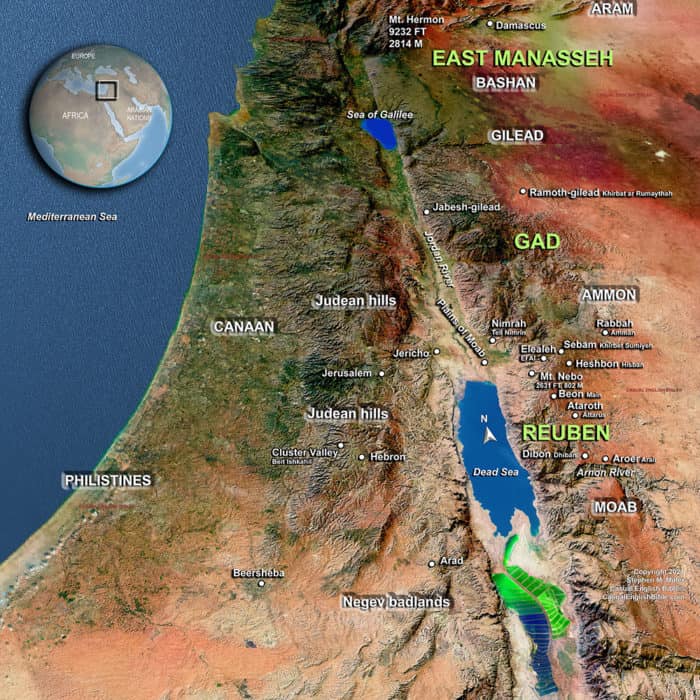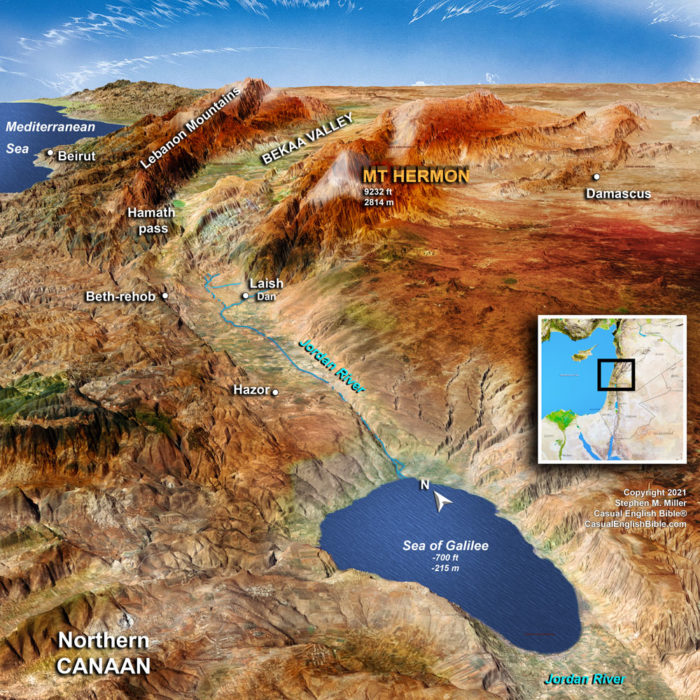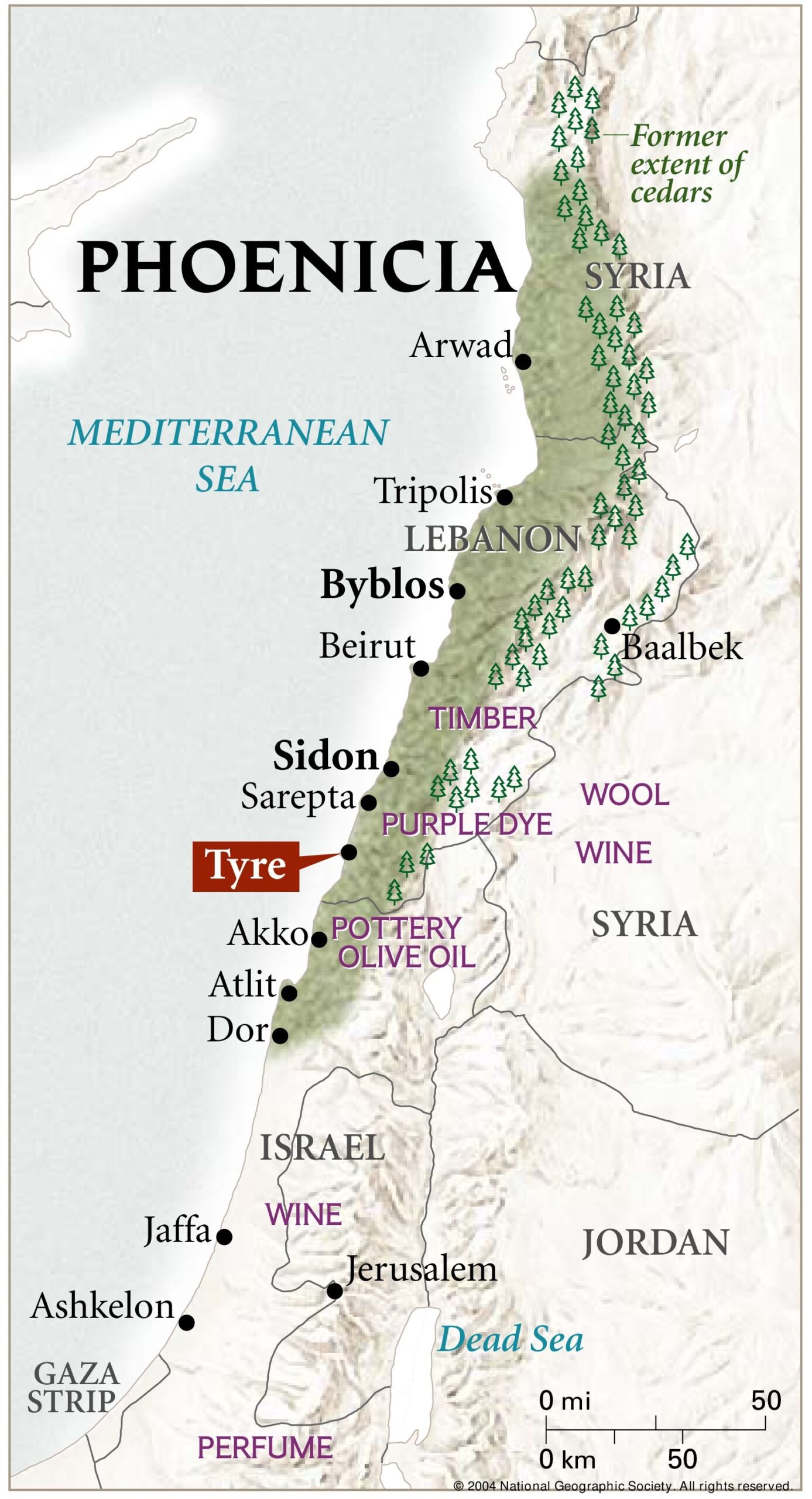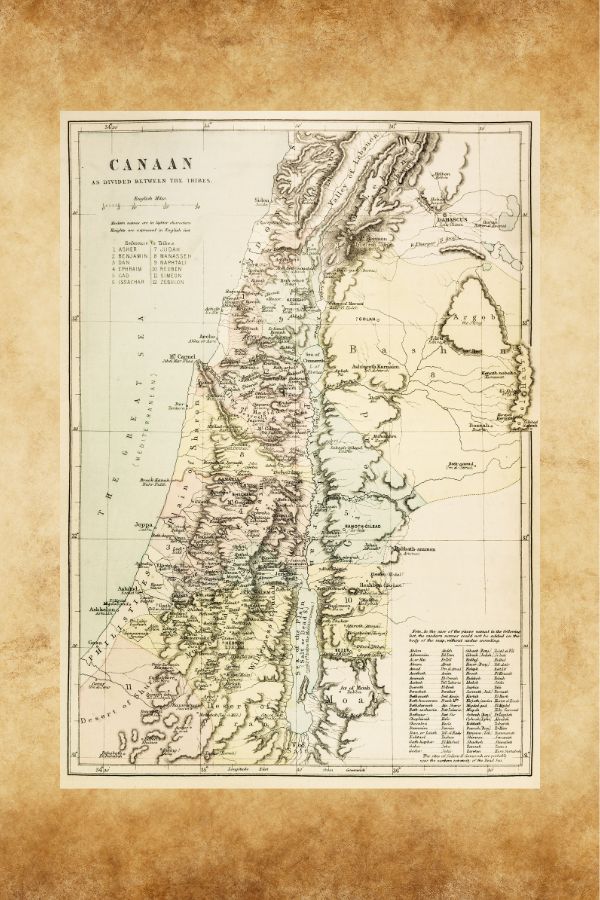Canaan
“ By the 17th century BCE, Jerusalem had developed into a fortified city under Canaanite rule, with massive walls protecting its water system.” Wikipedia

Image Credit: The Map as History
“The Bible gives a central place to the ‘Land of Canaan’, the territory that God gave Abraham and his descendants in the Book of Genesis. In the Jewish tradition, it is also known as the ‘Land of Israel’, the ‘Holy Land’ and the ‘Promised Land’.
“The frontiers of the Land promised to Israel by God vary from one Biblical text to another. Passages in Genesis and Deuteronomy give a utopian idea of an immense territory stretching from the Mediterranean Sea to Mesopotamia, [Gen.15.18; Deut.1.7 and 11.24].
“Other texts refer to a more restricted area with the Beqaa valley as its northern frontier. [see Num. 34.1-12; Judg. 3.3; 1 Kings 8.65; Amos 6.14].
“However, the majority of texts in the Bible [see Judg. 20.1; 1 Sam. 3.20; 2 Sam. 3.10; 17.11; 24.2 and 15; 1 Kings 5.5; Amos 8.14] suggest that Canaan’s approximate boundaries were Mount Hermon, which rises to 2,814 metres (9,232 ft) to the north (in Dan’s territory), Beersheba in the Negev Desert to the south, the Mediterranean to the west, and, to the east, the River Jordan, as a natural frontier from Mount Hermon through Lake Hula and Lake Tiberias to the Dead Sea.” The Map as History

Image Credit: Casual English Bible
Notice that Mount Herman is at the top of the above map–it is above and east of East Manasseh. The Sea of Galilee is below Mount Herman and south of the Sea of Galilee is the Jordan River. The Dead Sea is below the Jordan River.

Map Detail- Image Credit: Casual English Bible
CANAAN, CANAANITES
“In a restricted sense Canaan embraced the land W of Jordan occupied by the Israelites at the time of the Conquest. In a wider sense it included part of Syria; the people of the area were Canaanites. The term “Canaanite” is used in a few passages in the OT to denote “trader,” “merchant.”
“1. The name. Biblically the name both of people and the land derives from the ancestor Canaan referred to in Genesis 10:15-18.” Encyclopedia of the Bible
[Ham was the father of Canaan, and Ham was one of Noah’s sons.]
The Sons of Noah
18 The sons of Noah who came out of the ark were Shem, Ham and Japheth. (Ham was the father of Canaan.) Genesis 9:18.
10 This is the account of Shem, Ham and Japheth, Noah’s sons, who themselves had sons after the flood…
15 Canaan was the father of Sidon his firstborn,[g] and of the Hittites, 16 Jebusites, Amorites, Girgashites, 17 Hivites, Arkites, Sinites, 18 Arvadites, Zemarites and Hamathites.
Later the Canaanite clans scattered 19 and the borders of Canaan reached from Sidon toward Gerar as far as Gaza, and then toward Sodom, Gomorrah, Admah and Zeboyim, as far as Lasha. Genesis 10: 1, 15-18.
Canaan Is Also Associated with the Phonecian Traders and with Purple Dye
“The earliest document referring to Canaanites is an inscr. of Amenophis II c. 1440 b.c. reporting two campaigns in Asia. Among the war captives were 550 maryana, and 640 kyn’n.w. The maryana were a Hurrian military aristocracy and the kyn’n.w. another social group, prob. the merchant aristocracy of the coastal and trading centers of Syria and Palestine (B. Maisler, BASOR, 102 [1946], 9). Ugaritic texts from the 14th-13th centuries b.c. also refer to kncn and so this spelling is known both in Egypt and in Ugarit. The form kn’n.w. corresponds to the Akkad. kinaẖnia, kinnaẖẖu which is found in the Amarna letters. The W Sem. laryngeal ‘ often appears as h in Akkad. A lost Sem. word *kn’ (*kina-) meaning “murex” (shell fish which produces purple dye), has been proposed and the word Canaan is understood to mean “belonging to (the land of) Purple.” The Gr. name Phoenicia refers to the purple industry (φοινός, purple). The Hurrian texts from Nuzi E of the Tigris mention kinaḥḥu “red purple,” “dyed cloth” or “kna’-ian dye.”
“One can prob. trace the use of the term “Canaanite,” כְּנַעֲנִי׃֙ in Job 41:6 KJV; Isaiah 23:8; Ezekiel 17:4; Hosea 12:7; Zephaniah 1:11; Zechariah 11:7, 11, with the more restricted meaning of “merchant, trafficker” to the fact that the most characteristic Canaanite occupation was trading, in particular, trading in purple dye.
“2. Geographical extent. The term Canaan has both a restricted and a more extensive meaning, not merely in the Bible but also in the non-biblical sources.

Map of the Phonecian Shoreline
Image Credit: Reddit
“In some passages the term denotes the area of the Syro-Palestinian coastland, esp. Phoenicia proper to the N of Israel. In Genesis 10:15-19 the sons of Canaan are enumerated as Sidon the first-born, Heth and the Jebusites, the Hivites, the Arkites (modern Tell ‘Arqa in Lebanon preserves the name), the Sinites (modern Nahr as-Sinn, Sinn ad-Darb, Phoenician Usnu, Assyrian Usana or Sianu, Ugaritic ’sn), the Arvadites, the Zemarites (modern Sumra, N of Tripoli), and the Hamathites. In this list several items refer to towns along the coastal strip from northern Pal. to the Orontes (Gen 10:15-18). Canaan is defined as a son of Ham (9:18; 10:6) implying that the Canaanites were a Hamitic group, or perhaps under Egyp. domination. More specifically such passages as Numbers 13:29; 14:25; Joshua 5:1; 11:3; Judges 1:27ff. located the Canaanites on the coastlands and in the valleys and plains (including the Jordan Valley). Some support for this picture comes from the inscr. of Idrimi, king of Alalah, 15th cent. b.c., who refers to his flight to the seaport of Ammia in Canaan.
 Image Credit: Bible History. com
Image Credit: Bible History. com
“In such passages as Genesis 12:5; Numbers 33:51, the land of Canaan denotes the lands to the W of Jordan. The Canaanites are the inhabitants of this area (Gen 12:6; 50:11; Josh 7:9). The list in Genesis 10:15-19 concludes with the statement that the families of the Canaanites were spread abroad (10:18) and that the territory of the Canaanites was from Zidon to Gaza, inland to Sodom and Gomorrah, and northward via Admah and Zeboiim (in the Jordan Valley) to Lasha (location uncertain). Other important passages are Genesis 12:5; 13:12; Numbers 13:17-21; 34:1, 2 (where the vv. following define Canaan as approximately equivalent to Pal.). Jabin, whose capital was Hazor, is called “king of Canaan” (Judg 4:2, 23, 24).
This wider use of the term Canaan is known also in external sources. The Amarna letters of the 14th cent. b.c. refer to Canaan in terms which suggest the whole Syro-Pal. territory of Egypt. The Egyp. Papyrus Anastasi IIIA (lines 5, 6) and IV (16: line 4) of the 13th cent. b.c. mention “Canaanite slaves from Huru” (i.e. Syria-Pal.).
“3. The people. The list of the sons of Canaan in Genesis 10:15-19 includes a variety of peoples: Hittites, Jebusites, Amorites, Girgashites, Hivites, alongside the inhabitants of specific towns. Similar lists occur in Genesis 15:19-21; Numbers 13:29; Joshua 5:1; 11:3; etc. Some of these evidently represent smaller groups of people living in the general area of Canaan. The Hittites of Genesis 23 should prob. be identified with the sons of Heth of Genesis 10:15 and not with the Hittites of Asia Minor. The Hivites may represent Hurrians. Some of the groups have not yet been identified. Of particular interest are the Amorites (q.v.) who, like the Canaanites, represent both a specific and a wider group. Specifically, there were Amorite elements in the land, descended from the wave of Amorite migrants who entered W Asia early in the second millennium b.c. These were to be found in the hill country both E and W of Jordan (Num 13:29; 21:21-35; Josh 5:1; 11:3).
“More generally the terms “Amorite” and “Canaanite” seem to overlap. Thus in Genesis 10:15, 16 the sons of Canaan include Amorites, while in Numbers 13:17-21 Israelite spies search the land of Canaan but eventually occupy the land of the Amorites (Josh 24:15, 18). Abraham is promised the land of Canaan (Gen 12:5, 6; 15:18-21), but there is a delay in occupation because “the iniquity of the Amorites is not yet complete” (15:16). The town of Shechem was in the land of Canaan (12:5, 6) under the rule of Hamor the Hivite (34:2, 30), but the territory of Joseph, which included Shechem, is called Amorite territory (48:22).
“Non-Biblical sources likewise refer to the area of Syria-Palestine as the land of the Amorites. Thus the Alalaḫ tablets of the 18th cent. b.c. mention Amurru as part of Syria, and the Mari documents refer to Amorite princes in Hazor, the large Canaanite city in N Pal. The Amarna letters of the 14th-13th centuries b.c. point to Amorite control of the coastal regions of Canaan. Petty kings like Abdi-aširta, Aziru, etc. of the kingdom of Amurru in the mountains of Lebanon secured a hold on the coastal regions “from Byblos to Ugarit” (Amarna Letter No. 98). Rameses II (13th cent. b.c.) in his report of the Battle of Kadesh refers to the arrival of troops from “a port in the land of Amurru.”
“In both the Biblical and non-Biblical records two major groups of people occupied Pal. in the early stages of the Israelite conquest—Amorites and Canaanites. Solid opposition to the Israelites in Trans-Jordan and in the southern mountain areas W of Jordan came from Amorites (Num 21:21-23; Josh 7:7; 10:5), whereas the Canaanites were in the S at Arad in the Negeb (Num 21:1-3), the SE (Josh 13:3), at Gezer (16:10), along the coastal plains (17:11, 12), and around Hazor “the head of all those kingdoms” in the N (11:10; Judg 4:2). Both groups were, in any case, Sem., and spoke a related language. The archeological picture seems to be that the Amorites arrived in Pal. c. 2300 b.c. as nomads and destroyers of a pre-existing urban civilization. During four centuries, they left little behind them. Further N the Amorites amalgamated with the civilized population and out of the synthesis arose the Canaanite culture which spread S throughout coastal Syria and Pal. to reëstablish urban life in Pal. in the Middle Bronze age. It was this culture that the incoming Israelites found and largely adopted on the material side although their distinctive faith enabled them to emerge from its influence eventually.” Encyclopedia of the Bible
6. The history of the Canaanites. There is some uncertainty about the exact date when Canaanites appeared first in Syria-Pal. Certainly there were Sem. speaking peoples in the area in the third millennium, judging by a few Canaanite place names and loan words in Egyp. records. The oldest towns in Pal. have Canaanite names e.g. Megiddo, Beth-shean, Bethyerah, Jericho. In Syria, Ugarit, Gabala, Acre (’Irqatum), Tyre (Ṩur) are Canaanite.
“It is certain that the Canaanites and the related Amorites were well established in the region by 2000 b.c. when Syria-Pal. was divided among a varying number of Canaanite/Amorite city states. After the Amorite invasions had subsided, cultural influences from the N produced the standard Palestinian Middle Bronze Age Canaanite culture which was only slightly disturbed by the Hyksos movement.
EGYPT
“After the expulsion of the Hyksos from Egypt c. 1570 b.c., Egypt dominated Pal.-Syria once again during the 18th (c. 1570-1310 b.c.) and 19th (c. 1310-1200 b.c.) dynasties when numerous petty states existed in Canaan. During the 14th cent. northern city states like Ugarit came under Hitt. suzerainty. After the confusion of the Amarna age in the first half of the 14th cent. b.c. caused by Habiru incursions, Egypt regained control under the 19th dynasty, but lost it before the inroads of the Sea Peoples c. 1200 b.c. Merneptah’s raid of c. 1220 b.c. was at best abortive, and the raid of Rameses III c. 1180 b.c. was superficial, being confined to the main routes.
THE ISRAELITES
“The Israelites soon gained control of the highlands, but possession of the valleys and coastal regions was a slow process. In Canaan as a whole, areas to the SW of old Canaan fell to the Sea Peoples (Philistines), Syria itself was occupied by Arameans, and the Canaanites were confined to the coastal areas that became known as Phoenicia. In Pal. the surviving Canaanites were absorbed by the Israelites.
7. Society. The Canaanite social structure was akin to that which prevailed all over the Ancient Near East; i.e., it was comprised of city states in which the king had wide powers to appoint and conscript his subjects for military service, to control lands and lease them for services rendered, to impose taxation of various kinds, and to compel his subjects to undertake public works (corvée). This state of affairs is implied in 1 Samuel 8, c. 1050 b.c. and is seen at first hand in the Alalaḫ tablets (18th-15th centuries) and at Ugarit (14th-13th centuries b.c.). Military, economic, and religious matters were under the king’s control. The queen held a significant place and was appealed to at times by high officials. In larger states the court was highly organized.
“There were several strata in society, such as freemen, semi-freemen (clients), and slaves. The slaves comprised war captives, foreign slaves, and native Canaanites who became slaves because of debt, unemployment, or because parents sold them or exposed them as children. Slaves might belong to the state, to the temple, to private landowners, or to craftsmen.
“The economy was based on agriculture. All land was owned by the state, the temples and private landowners, although tenant farmers, the ḫupši, possessed small areas. One of the Amarna letters of Rib-Addi of Byblos tells how hupši farmers were forced at times to sell the wood of their houses and even their children to buy food.
“Guilds were widespread throughout society among farmers, artisans, traders, priests, musicians and warriors. One important group of professional warriors was the maryannu who possessed superior equipment such as the horse-drawn chariot. They rendered special services to the king and received special privileges.
“Since society was basically feudal much of the land was held as a grant from the king. Members of the royal family, state officials, the maryannu and others, owed the king specified services and taxation in return for their lands. There was a severe difference in living standards between the upper class patricians and the wide range of lower class people such as half-free serfs, slaves, etc. Some evidence of class distinction comes from excavations which reveal some fine houses and many inferior houses.
“The population was distributed in the larger towns and their numerous associated villages or suburbs (many references in Josh 13ff.).
“8. Literature. The excavations at Ugarit revealed an unsuspected world of Canaanite lit. The texts which date from the early 14th cent. b.c. are written on clay tablets in the special thirty-letter cuneiform alphabet.
“Among the more important epics are three: the Baal Epic, which recounts the deeds and fortunes of Baal or Hadad; the legend of Aqhat the only son of the good King Dan’el; the story of King Keret who was bereft of his family and took another wife by conquest, thus incurring the wrath of the gods. There are fragments of other stories as well as a wide variety of letters, treaties, etc.
“Important insights into Canaanite religious beliefs, and into numerous aspects of national and family life shine through these epics.
9. Religion.
“a. The pantheon. The OT gives hints of a Canaanite pantheon which is now known to have been extensive. The senior deity was El to whom matters were referred by other gods. For practical purposes, however, Baal (Lord) was more significant. He is known in the OT in his various local manifestations as the fertility god par excellence and is to be equated with Hadad the storm god. Both he and Dagon had a temple in Ugarit. The god Aṭtar was Baal’s substitute during his absence in the underworld. He was the son of Aṭerat, the consort of El. Among the goddesses were Anath, Asherah, and Astarte (Ashtaroth), goddesses of sex and war. Anath was important in agricultural rituals. She is associated with Aṭtarat, the Canaanite Astarte deliberately misvocalized by Jewish scribes as Ashtoreth. The third goddess, Asherah (Aṭerat) was consort of El though confused with Astarte in Pal. Some doubt remains as to whether a god Yah or Ya’u was known among the Canaanites, but the gods Shaḥru (Dawn star), Shalmu (Evening star) and Yarhu the Moon god and his consort Nikkal were certainly worshiped. Others were Resheb, the god of pestilence and death, Mot the power of drought and death, the antagonist of Baal.
“b. The cult. The Ras Shamra texts enable one to make some kind of reconstruction of the cult at Ugarit. One text gives a list of gods and their appropriate offerings. Among the offerings were the šrp or burnt offering wholly offered to the deity and šlmm or communion offering in which both worshipers and deity shared. Among the technical terms which are paralleled in Heb. are dbh “sacrifice,” mtn “gift,” ndr “vow.” Among the animals offered in sacrifice were sheep and oxen. There were singers and some kind of psalmody, and times and seasons were observed. The phases of the farmer’s year were celebrated by appropriate rites and the recital of the proper myths.
c. Cultic personnel. At Ugarit there was a high priest and no less than twelve families of priests (khnm). In ancient times the king exercised some priestly functions which he retained in part in later times. Among the cultic functionaries were priests (khnm), consecrated persons (qdšm), singers (šrm), makers of vestments, sculptors and others. The priests were also custodians of the literary tradition which they taught. There seem also to have been women among the temple personnel associated with the fertility cult.
d. The temples. Canaanite temples have been excavated in Syria and Pal. Among the most famous of these is the Late Bronze Temple of Lachish (q.v.), the temples at Megiddo and Jericho from c. 3000 b.c., three at Megiddo from c. 1900 b.c., two at Beth-shan from the Late Bronze Age and several important temples at Hazor from the Late Bronze Age also. A wide variety of cultic objects, altars, incense stands, knives, tongs, libation vessels, etc. is available for study. The debris on the floors of the temples often yields bones of animals which give an idea of the types of sacrifices offered.
10. Israel and Canaan. Israel owed a great deal to Canaan on the level of material culture in which the Canaanites were superior. It is not easy to say how much Israel owed to the Canaanites in the area of lit. although Canaanite themes and meters and language are common in the Psalms. There was considerable correspondence between Hebrew and Canaanite religion at least in a superficial way. It is the essential differences between Canaanites and Israelites that are important, however, for it was these that enabled Israel to break away from what was essentially a baneful influence. Those in Israel who worked at a superficial level were attracted to the Canaanite way of life, which lacked the austerity and high ethical demands of the faith of Israel. It was the task of the prophets to draw the lines strongly between the worship of Baal and the worship of Yahweh. The way of Ahab, challenged by Elijah, could end only in the destruction of Israel for it confused Baal with Yahweh and destroyed the unique covenant relationship between Yahweh and Israel. The challenge of Elijah on Mount Carmel, “If Yahweh is God, follow him; but if Baal, then follow him” summarizes in succinct form the problem that the prophets faced over many centuries.” The Encyclopedia of the Bible
Discover more from Jacki Kellum
Subscribe to get the latest posts sent to your email.
